By Heather Rockwood, Communications Associate
Today is #NationalSiblingsDay! To celebrate, I took a look into the collections of the MHS to see if there are any historically significant siblings. What I found exceeded my expectations, as the MHS has collection pieces from the Otis family, one of my favorite Massachusetts families of the 1700’s. Specifically I’ll be talking about James Otis, Jr., Mercy Otis Warren, and Mary Otis Gray, three siblings who lived through very interesting times.
The eldest of the three is James Otis, Jr. who was a lawyer, political activist, and legislator in the Massachusetts Provincial Assembly and a mentor to John Adams. Otis is famous for representing businessmen of Boston during the Writs of Assistance case in 1761 where he argued against invasion of property without cause. This case, and the arguments he made, was the basis for the Fourth Amendment of the Bill of Rights, since John Adams witnessed the impassioned four-hour speech made by Otis and helped write the Massachusetts Constitution and the Constitution of the United States. Unfortunately, Otis suffered from mental illness and became much more erratic after he was hit in the head during an altercation in 1769. Although he lived during the time of the Revolutionary War, he did not take part, as his family placed him in a friend’s house in Watertown, where he passed in 1783 after being struck by lightning. His sister Mercy later stated that he had said to her: “My dear sister, I hope, when God Almighty in his righteous providence shall take me out of time into eternity that it will be by a flash of lightning.”
Mercy Otis Warren, the eldest sister, but younger than James, was a Patriot before and during the Revolutionary War and an author. She wrote pamphlets, poems and plays to further the patriotic cause. She published under her own name, unusual for a woman in her social circle, and wrote one of the earliest histories of the American Revolution, the first authored by a woman. Her brothers and father supported her education as a girl, also, unusual for the time and her social circle, as she was a voracious reader, so she studied with her brothers under a tutor. She was a correspondent and advisor to many political men including Samuel Adams, John Adams, John Hancock, Patrick Henry, Thomas Jefferson and George Washington. Alexander Hamilton complimented her plays: “In the career of dramatic composition at least, female genius in the United States has outstripped the male”. However, Warren’s sharp wit criticized John Adams in her history of the American Revolution, “History of the Rise, Progress and Termination of the American Revolution” which many contemporaries read after publication in 1805. These criticisms created a breach of the lifelong friendship she enjoyed with Abigail and John Adams. The friendship was reestablished with Abigail in 1812 just two years before Warren passed at age 86. She was a woman ahead of her time, and I’ve always wondered what she could have accomplished had she lived during our time. The MHS holds Mercy Otis Warren’s papers, mostly her correspondence.

Mary Otis Gray did not have the patriotic fervor of her two siblings, she lived a quieter life, despite being “raised in the midst of revolutionary ideals” which influenced her siblings heavily. She married John Gray, a Boston businessman, collector of customs before the war, and owner of the ropewalks made famous by the brawls between soldiers and civilians leading up to the Boston Massacre in 1770. The Grays married when Mary was thirty-one in 1761, older than was customary for the time, and she bore a son, John, in 1763, the same year she sat for this portrait. However, John passed six days after birth and Mary passed later that year. See the image of Mary Otis Gray along with the mourning jewelry made for her and for her son.

